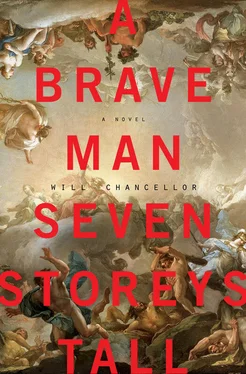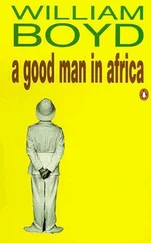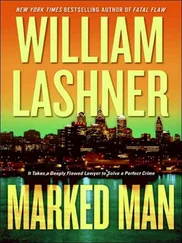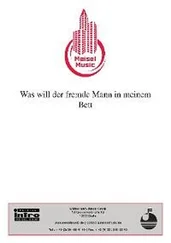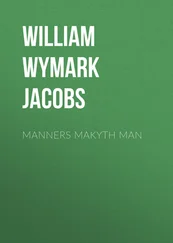Kurt looked like he might hit him.
— You cocksucker. Lorie Nussbaum wrote that about me in the Capo Press monograph. The quote was, “He did nothing for a decade, everyone for a year, then changed art forever in mere minutes.” I have the fucking article in my press kit.
Hal lit a cigarette.
— Sorry. That’s right. I must have read that article a thousand times.
— Actually there is no article. But that’s what I’m talking about. If your balls are big enough, then facts become fiction and fiction becomes fact. All that micro bullshit is for watchmakers and carpenters.
Owen thought of asking where they were going, but was afraid he would open himself up to a whole continental critique of American banality—“Where are we going?” being a species of the “What do you do?” genus. After a few minutes, Brigitte spoke:
— How do you know Kurt?
Kurt wheeled up quickly and answered:
— Owen and I are collaborating on a project.
This was the first time Owen had heard it announced.
— Are you going to make him famous?
— The critics are going to make him famous; I’m just bringing him to their attention. Did you invite any of your friends tonight? We could set him up with someone.
— What if I want him for myself?
Once Brigitte was a few steps ahead, ruffling Hal’s hair, Owen asked Kurt which artists he admired.
— Admire? If you admire art, you’re buying it. I make shit.
Owen pressed him for a reference.
— I don’t know. There are people you rip off or whatever.
Owen decided to be provocative:
— I’ve seen photos of your work. Is everything you do art?
— Absolutely.
Now Hal turned around, surprised at hearing what sounded like a heartfelt answer. Kurt continued:
— Art is problem solving. And I’ve got lots of problems.
Hal laughed. Owen asked Kurt to clarify.
— Picture a guy. He has this great idea for a sculpture, but he can’t sleep because of a problem: How do I make it look like this guy is thinking and not taking a shit? So he paces the planks of his atelier for a few weeks. He notes how his own muscles contract when he sits. He calls in models. He makes them squat. Asks a few to take a shit for contrast. They think he’s depraved. He sculpts models, all at various angles of exertion. But in the end, he solves the fucking problem. And it’s beautiful. And that man’s name is fucking Rodin. There is no doubt that we are looking at a man thinking . What’s art? That’s art.
Hal suggested a new work:
— You should re-enact that story as a performance piece.
Brigitte asked if the story was true.
— Art is telling people what to think. If a work is open to other interpretations, it means you failed as an artist. There are always problems with how something can be seen. Artists end the discussion. Try getting hundreds of homeless people to wear tuxedos and remove the possibility that you’re making a fashion statement or some Marxist bullshit economics thing. Try filling the Stedelijk with Ping-Pong balls and have critics recognize it’s a comment on flotation and not a birthday party for five-year-olds.
Owen was a little lost:
— You filled what with Ping-Pong balls?
— The Stedelijk. It’s a museum in Amsterdam. Twelve million bright orange Ping-Pong balls. I originally wanted to fill the Reichstag, to float off the Christo shroud, but I wasn’t Reichstag-big until 2002. And besides, the piece fit with the whole boat concept of the renovation they were planning.
Brigitte had the final word:
— Genius.
Just past Mitte, they took an elevator to a bar. Until the ping of the top floor, Kurt told a story about convincing a hospital to collect newborns’ breath in balloons. These balloons were then used by botanists to grow constellations of baby’s breath, Gypsophila , from the baby’s breath. Unfortunately all the flowers died within a week.
— And that’s when I learned the first rule of being a professional artist: Always have something to sell.
Owen scanned the elevator to see if anyone else was grimacing. Brigitte and Hal were texting, and the other patrons looked cowed, already forming the story of the one night they hung out with Kurt Wagener.
The steel doors opened to a riot. The crowd, mostly models jumping up and down to electro and guys with pursed lips fist-pumping, cleared a path for Kurt and his entourage. They passed from the main room to the back bar with the pomp of Dalí in 1920s Paris. Those with their backs turned sloshed drinks and spun in flushes of anger before realizing it was Kurt Wagener who had ridden up their heels. Kurt gathered apologies as if they were roses tossed at a curtain call. Then, at the back bar, a group of suits erupted in cheers when they saw Kurt and Hal.
I’ve lost the crowd that would applaud my entrance, Owen thought.
Hal explained Kurt’s celebrity among celebrities:
— Kurt’s a member here… so to speak.
Hal jerked his head toward the bar. Owen didn’t follow until the bartender stepped aside: above the bar was a large-format photograph of Kurt, naked in his wheelchair, leaning forward with a grin and spilling down the pleather seat on the brink of tumescence. Berlin was no Paris, Owen realized, and this was no longer the 1920s.
Hal spoke before Owen could react:
— It’s the best portrait I’ve taken.
Brigitte explicated the significance Owen missed:
— Kurt explores the distinction between body and body part.
Hal explained further:
— It’s called Pedicabo , which means “I’ll fuck you” or something, in Greek.
Owen let Hal’s translation stand; philology was the least of his concerns, now that he was looking at a full-frontal picture of his host. But the Latin came out anyway:
— Pedicabo et irrumabo te?
— Ha! You do know shit. You’ve got to meet Stevie. She’s the one who named it. It’s a brilliant name, right?
The bartender vouched:
— The owners want to change the name from 66 to the Pedicabo Bar.
— You took me to a bar with your nude, wall-sized portrait?
Again, everyone was watching Owen. He tried to find the Dionysian mood that always eluded him when he needed it most:
— That’s the stupidest thing I’ve ever seen.
Kurt chose to take the remark as a compliment and shook Owen’s hand.
The bartender poured shots of green Chartreuse for the group. Owen was starting to see himself from a great remove. It happened to him whenever he was in this sort of environment. Thankfully, his words and demeanor were someone else’s — someone fun and revolting, Hephaestus in a Dionysus mask.
— Where am I?
Brigitte didn’t appear to catch the question; she just leaned closer.
A young man with a wild Nietzschean mustache, bright red and flying from his lip like a barn on fire, stood at Owen’s shoulder, waiting to be introduced.
— Jera, this is Owen.
Jera looked Owen in the eye and nodded once as if he were firmly shaking Owen’s hand. Something in Jera invited Owen to widen his stance until their gaze was level.
— Did you order him from a catalog? Does he know what he is getting himself into?
Jera spoke to Hal in German, presuming Owen wouldn’t understand. And Owen, for his part, opened his mouth a little wider, hoping Jera and Hal would assume he hadn’t understood.
— Kurt wants to use him for something. But he keeps surprising us, so who the fuck knows what’s going to happen!
Hal laughed. Jera didn’t.
The music was its own punch line. The crunch and warble buried any hope of conversation. Jera shouted over the music:
— Have you ever heard of Jörg Immendorff? He’s the guy at the end of the bar in the black shirt with the five o’clock shadow. He’s the Gertrude Stein of the circle you’ve wandered into — of course, you have to imagine Gertrude Stein orchestrating cocaine-fueled orgies.
Читать дальше
